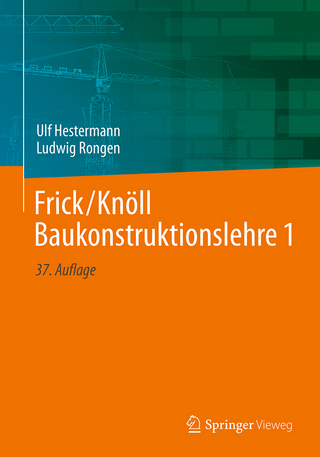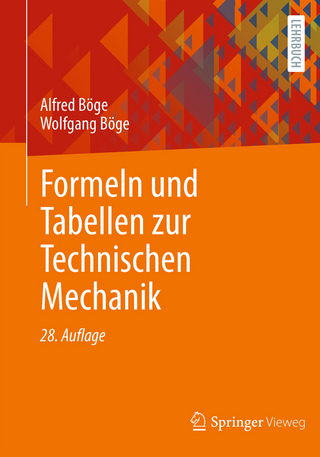
Design of Buildings for Wind
John Wiley & Sons Inc (Verlag)
978-0-470-46492-2 (ISBN)
- Titel ist leider vergriffen;
keine Neuauflage - Artikel merken
ASCE 7 is the US standard for identifying minimum design loads for buildings and other structures. ASCE 7 covers many load types, of which wind is one. The purpose of this book is to provide structural and architectural engineers with the practical state-of-the-art knowledge and tools needed for designing and retrofitting buildings for wind loads. The book will also cover wind-induced loss estimation. This new edition include a guide to the thoroughly revised, 2010 version of the ASCE 7 Standard provisions for wind loads; incorporate major advances achieved in recent years in the design of tall buildings for wind; present material on retrofitting and loss estimation; and improve the presentation of the material to increase its usefulness to structural engineers. Key features:
New focus on tall buildings helps make the analysis and design guidance easier and less complex.
Covers the new simplified design methods of ASCE 7-10, guiding designers to clearly understand the spirit and letter of the provisions and use the design methods with confidence and ease.
Includes new coverage of retrofitting for wind load resistance and loss estimation from hurricane winds.
Thoroughly revised and updated to conform with current practice and research.
Emil Simiu, PE, PhD, is a NIST Fellow and a Fellow at the American Society of Civil Engineers. He served as chairman of its Committee on Wind Effects, Committee on Dynamic Effects, and Committee on the Reliability of Offshore Structures; as senior structural engineer with Severud Associates and Ammann & Whitney, Inc.; and as distinguished research professor at Florida International University's International Hurricane Research Center. Also a distinguished member of the ASCE Standard Committee on Loads, he was a recipient of the Federal Engineer of the Year award from the National Society of Professional Engineers, and of the 2006 Japan Association for Wind Engineering Prize, given to the outstanding wind engineering publication of the year, for the first edition of Design of Buildings and Bridges for Wind. In addition, Dr. Simiu is the coauthor of Wind Effects on Structures, Third Edition (Wiley).
PREFACE xi PART I INTRODUCTION 1
1 OVERVIEW 3
PART II GUIDE TO THE ASCE 7-10 STANDARD PROVISIONS ON WIND LOADS 7
2 ASCE 7-10 WIND LOADING PROVISIONS 9
2.1 Introduction / 9
2.2 ASCE 7-10 Standard: An Overview / 10
2.3 Organization of the Guide: Chapters 3 to 9 / 19
3 REGULAR AND SIMPLIFIED APPROACH: RISK CATEGORY, BASIC WIND SPEED, ENCLOSURE, EXPOSURE, TOPOGRAPHIC FACTOR 21
3.1 Risk Category (ASCE Table 1.5-1) / 21
3.2 Basic Wind Speed V (ASCE Sect. 26.5, ASCE Figs. 26.5.-1a, b, c) / 22
3.3 Enclosure Classification (ASCE Sects. 26.2 and 26.10) / 23
3.4 Exposure Category (ASCE Sect. 26.7) / 24
3.5 Topographic Factor Kzt (ASCE Sect. 26.8, ASCE Fig. 26.8-1) / 27
4 REGULAR APPROACH: STEPS COMMON TO ALL BUILDINGS/OTHER STRUCTURES (MWFRS AND C&C) 31
4.1 Introduction / 31
4.2 Regular Approach: Steps Common to All Buildings and Other Structures (MWFRS and C&C) / 32
5 REGULAR APPROACH: BUILDINGS, PARAPETS, OVERHANGS (‘‘DIRECTIONAL’’ PROCEDURE), MWFRS 37
5.1 Introduction / 37
5.2 Regular Approach: Enclosed or Partially Enclosed Buildings of All Heights, MWFRS / 37
5.3 Regular Approach: Roof Overhangs and Parapets, MWFRS / 53
5.4 Regular Approach: Open Buildings with Monoslope, Pitched, or Troughed Free Roofs, MWFRS / 55
6 REGULAR APPROACH: LOW-RISE BUILDINGS, PARAPETS, OVERHANGS (‘‘ENVELOPE’’ PROCEDURE), MWFRS 57
6.1 Net Pressures on Walls and Roof / 57
6.2 Comparison Between Results Based on ASCE Sects. 27.4.1 and 28.4.1 / 62
6.3 Regular Approach: Parapets and Roof Overhangs, MWFRS / 63
7 REGULAR APPROACH: STRUCTURES OTHER THAN BUILDINGS, MWFRS 65
7.1 Solid Freestanding Walls and Solid Signs / 65
7.2 Open Signs, Lattice Frameworks, Trussed Towers / 69
7.3 Chimneys, Tanks, Rooftop Equipment, and Similar Structures / 74
7.4 Solid Attached Signs / 75
7.5 Rooftop Structures and Equipment on Buildings / 77
8 SIMPLIFIED APPROACH: ENCLOSED SIMPLE DIAPHRAGM BUILDINGS, PARAPETS, OVERHANGS (MWFRS) 81
8.1 Simplified Approach: Class 1 Buildings, Walls and Roof, MWFRS / 81
8.2 Simplified Approach: Parapets, MWFRS / 85
8.3 Simplified Approach: Roof Overhangs, MWFRS / 85
8.4 Simplified Approach: Class 2 Buildings, Walls and Roof, MWFRS / 86
8.5 Simplified Approach: Simple Diaphragm Low-Rise Buildings, MWFRS / 90
9 REGULAR AND SIMPLIFIED APPROACHES: C&C 95
9.1 Introduction / 95
9.2 Regular Approach / 95
9.3 Simplified Approaches / 105
PART III WIND ENGINEERING FUNDAMENTALS 107
10 ATMOSPHERIC CIRCULATIONS 109
10.1 Atmospheric Hydrodynamics / 109
10.2 Windstorms / 113
11 THE ATMOSPHERIC BOUNDARY LAYER 117
11.1 Wind Speeds and Averaging Times / 118
11.2 Wind Speed Profiles / 121
11.3 Atmospheric Turbulence / 130
12 EXTREME WIND SPEEDS AND WIND-INDUCED EFFECTS 137
12.1 Wind Speed Data / 138
12.2 Cumulative Distributions, Exceedance Probabilities, Mean Recurrence Intervals / 141
12.3 Parametric Estimates of N-Year Wind Speeds; Closed Form Estimators; Software / 143
12.4 Probabilistic Estimates of Wind Effects Based on Nondirectional and Directional Wind Speed Data / 149
12.5 Development of Directional Databases of Hurricane Wind Speeds / 153
12.6 Development of Directional Databases of Non-Hurricane Wind Speeds / 155
12.7 Non-Parametric Statistics, Application to One-Dimensional Time Series / 157
12.8 Error Estimates / 159
13 BLUFF BODY AERODYNAMICS BASICS; AERODYNAMIC TESTING 163
13.1 Introduction / 163
13.2 Bluff Body Aerodynamics / 163
13.3 Aerodynamic Testing / 173
13.4 Low-Frequency Turbulence and Aerodynamic Pressures on Residential Homes / 183
14 STRUCTURAL DYNAMICS 185
14.1 Introduction / 185
14.2 The Single-Degree-of Freedom Linear System / 186
14.3 Continuously Distributed Linear Systems / 190
14.4 Time Domain Solutions for Three-Dimensional Dynamic Response / 199
15 AEROELASTICITY 203
15.1 Introduction / 203
15.2 Vortex-Induced Oscillations / 205
15.3 Galloping / 206
15.4 Flutter / 210
16 STRUCTURAL RELIABILITY UNDER WIND LOADING 217
16.1 Introduction / 217
16.2 First-Order Second-Moment Approach, Load and Resistance Factors / 220
16.3 Dependence of Wind Effects on Wind Directionality / 225
16.4 Structural Strength Reserve / 226
16.5 Design Criteria for Multi-Hazard Regions / 228
16.6 Individual Uncertainties and Overall Uncertainty in the Estimation of Wind Effects / 229
16.7 Calibration of Design MRIs in the Presence of Dynamic Effects or of Large Knowledge Uncertainties / 232
17 LOSS ESTIMATION 237
17.1 Introduction / 237
17.2 Elements of Damage Estimation Procedures / 238
17.3 Loss Estimation / 245
PART IV WIND EFFECTS ON BUILDINGS 247
18 RIGID BUILDINGS 249
18.1 Introduction / 249
18.2 Database-Assisted Design (DAD) / 252
18.3 Wind Directionality Effects / 258
18.4 Uncertainties in the Estimation of Wind Effects / 259
19 TALL BUILDINGS 261
19.1 Introduction / 261
19.2 High-Frequency Force Balance Approach (HFFB) / 263
19.3 Aeroelastic Effects. Testing Based on Strain Measurements / 265
19.4 Database-Assisted Design / 269
19.5 Serviceability Requirements / 278
19.6 Preliminary Estimates of Flexible Building Response / 279
PART V APPENDICES 287
APPENDIXA1 RANDOM PROCESSES 289
A1.1 Fourier Series and Fourier Integrals / 290
A1.2 Parseval’s Equality / 291
A1.3 Spectral Density Function of a Random Stationary Signal / 292
A1.4 Autocorrelation Function of a Random Stationary Signal / 293
A1.5 Cross-Covariance Function, Co-Spectrum, Quadrature Spectrum, Coherence / 295
A1.6 Mean Upcrossing and Outcrossing Rate for a Gaussian Process / 296
A1.7 Probability Distribution of the Peak Value of a Normally Distributed Random Signal / 297
A1.8 Probability Distribution of the Peak Value of a Non-Gaussian Random Signal / 298
APPENDIXA2 MEAN WIND PROFILES AND ATMOSPHERIC BOUNDARY LAYER DEPTH 301
A2.1 Equations of Balance of Momenta within the Atmospheric Boundary Layer / 301
A2.2 The Turbulent Ekman Layer / 302
APPENDIXA3 SPECTRA OF TURBULENT VELOCITY FLUCTUATIONS, KOLMOGOROV HYPOTHESES 307
APPENDIXA4 WIND DIRECTIONALITY EFFECTS, OUTCROSSING AND SECTOR-BY-SECTOR APPROACHES 311
A4.1 Approach Based on the Outcrossing of the Limit-State Boundary / 311
A4.2 The Sector-By-Sector Approach [18-10] / 313
APPENDIXA5 REPORT ON ESTIMATION OF WIND EFFECTS ON THE WORLD TRADE CENTER TOWERS 315
REFERENCES 323
INDEX 333
| Erscheint lt. Verlag | 28.10.2011 |
|---|---|
| Zusatzinfo | Photos: 17 B&W, 0 Color; Drawings: 60 B&W, 0 Color |
| Verlagsort | New York |
| Sprache | englisch |
| Maße | 163 x 244 mm |
| Gewicht | 608 g |
| Themenwelt | Technik ► Bauwesen |
| Technik ► Elektrotechnik / Energietechnik | |
| ISBN-10 | 0-470-46492-5 / 0470464925 |
| ISBN-13 | 978-0-470-46492-2 / 9780470464922 |
| Zustand | Neuware |
| Informationen gemäß Produktsicherheitsverordnung (GPSR) | |
| Haben Sie eine Frage zum Produkt? |
aus dem Bereich


